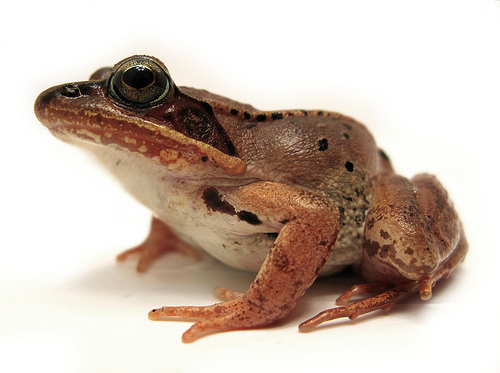Wood Frogs (Lithobates sylvaticus) Freeze Solid Over Winter and Then Come Back to Life in Spring

Here in North America there are a wide variety of toads and frogs but perhaps none are so unusual as the wood frog. These frogs are found in Eastern North America, Canada, and up into Alaska. On a warm spring night you might hear them singing(click her for sound clip) near bogs, vernal pools, or upland forests but something remarkable happens to them this time of year in the winter, they freeze solid. Now freezing solid isn't remarkable by itself, but what is remarkable is that the frogs will literally come back to life in the Spring after having no heartbeat or brain activity, and they don't breathe, for up to eight weeks! This baffles and amazes scientists, who are actively studying them even now.

Wood frogs are amphibians, and exotherms, which means that their internal body temperature is affected by their surroundings. But unlike their relatives they do not hibernate deep in ponds or lakes or bury into the leaves and mud of stream banks. During winter most amphibians go into a period of dormancy, but they don't freeze solid, their cells and bodies stay relatively thawed, though cool, and they are inactive until the warmer weather returns.
So How and Why Do Wood Frogs Freeze?
There are different schools of thought about why wood frogs freeze solid, but one of the ideas is that they freeze so that they are the first ones "up" in the spring. A remarkable part of their natural history is that wood frogs move around a lot. They migrate to spend summer months in upland forests, but around fall and winter they move towards the uplands and slopes surrounding their preferred vernal pools (pools that dry up after filling with water in the spring). Because these frogs depend on vernal pools, that might dry up very early in Summer, it makes sense they they would want to "get a jump" on the competition for the pools by waking up early in Spring and laying eggs as early as possible. Because the upland forests and the ground in which they hibernate thaws earlier than the water and mud in which other amphibians hibernate in, the wood frogs wake up earlier than most species of frog. In the Spring they are one of the first frogs to emerge, along with Spring Peepers.

So how does this freezing solid stuff work? Ok, time for the sciency information. If you remember, most living things are made out of water. Well, the wood frog is too, which means that water plays a crucial part of the freezing and thawing process. Birds, reptiles, and amphibians secrete waste in the form of uric acid. This is the white pasty stuff that you find on your windshield. Uric acid is an efficient way to remove waste because it is insoluble (doesn't dissolve) in water and allows water to be reabsorbed into their bodies where it's needed while the waste is passed on out the poop shoot. Wood frogs have found a way to use this uric acid, along with a type of sugar that they create inside their bodies, to help them in the freezing process.
When the temperature drops outside, and the world begins to freeze, the wood frog begins to accumulate uric acid in its tissues. Along with this the frogs also begin converting glycogen (sugars) in their liver and distributing this through out their body tissues. Glycogen and urea are important because they act to limit the amount of ice that forms INSIDE the cells of the frog's body, while allowing ice to form outside of the frog's cells. When the frog begins to freeze it draws water from the inside of its cells into its body cavity, and the water surrounds the major organs inside of it. The uric acid and glycol prevents the small amount of water that remains inside the cells of the frog's organs from freezing, but the water surrounding the organs, heart, etc. all freezes solid.

In the spring the most amazing part of this process happens. When the temperature goes above freezing the frog begins to thaw. Now common sense would say that the frog would begin to thaw from the outside in, but it doesn't happen this way. The frog actually begins thawing from the inside out! No one is sure how this happens or how the frog even starts its heart beating again.
Watch this incredible video by Robert Krulwich on MPT http://video.pbs.org/video/1506734069/.
What can we learn from wood frogs?
There are many applications that scientists and researchers are trying to learn from wood frogs. Could they give us a clue to cryogenics (freezing and waking up humans)? Could they help us unlock the mystery of diabetes? After all wood frogs can withstand blood sugar (glucose) levels nearly 100x higher than normal without suffering ill effects. Humans can only manage blood sugar levels around 2-10x higher (NPS Tales of the Arctic). People in the field of biomimicry (learning from nature) are are looking at wood frogs and their biology to create new forms of antifreeze that might be used in vehicles or machines that operate in cold temperatures.
When walking in the woods this winter think about the wood frog-cicles frozen underground waiting to reemerge in the Spring. They are truly one of nature's miracles.

